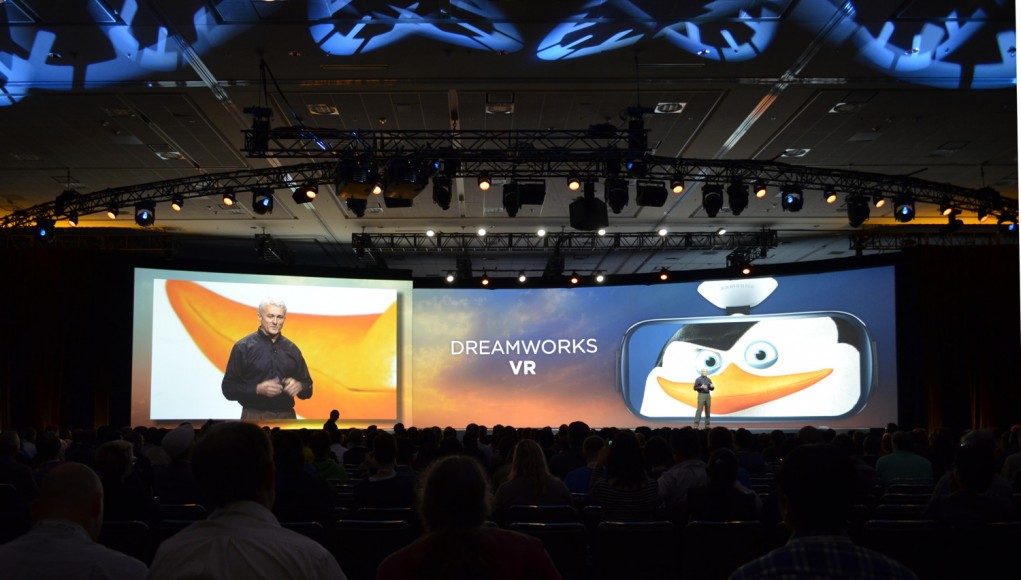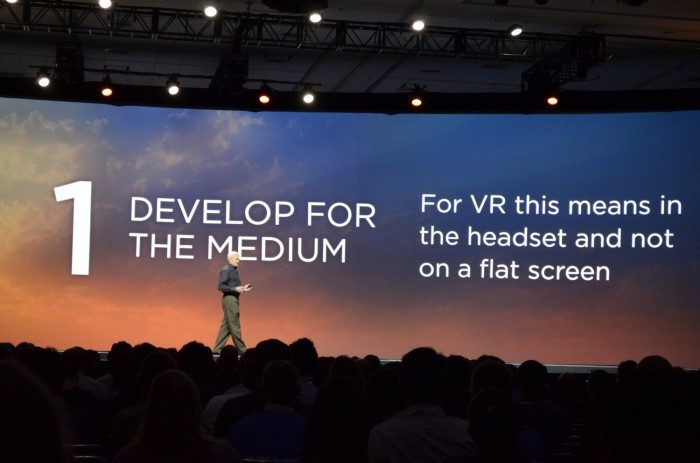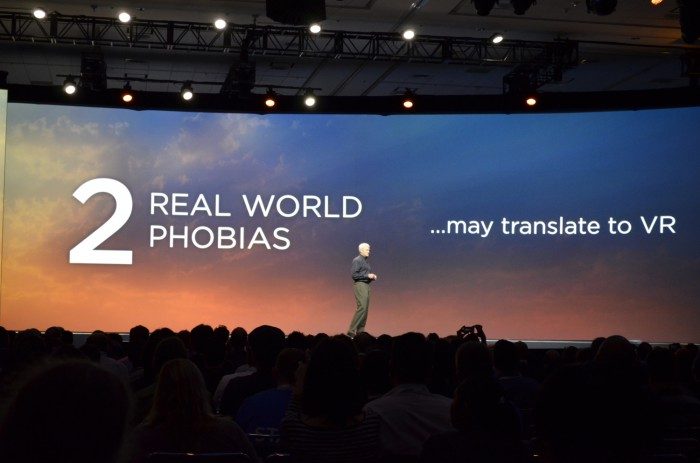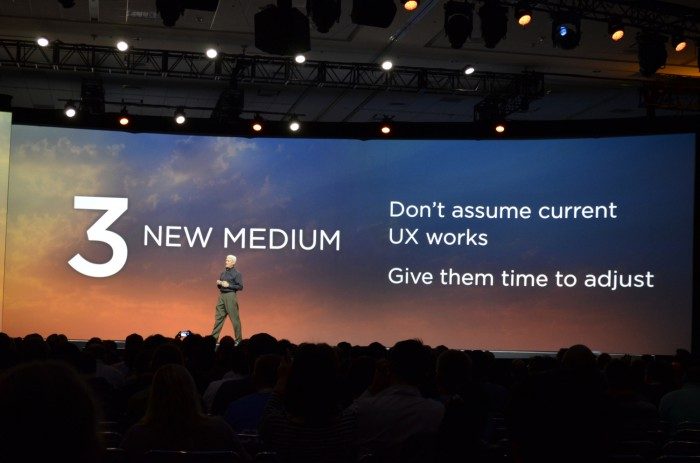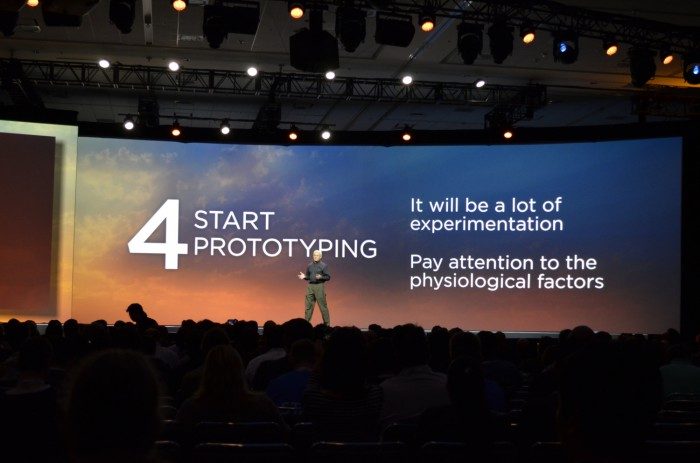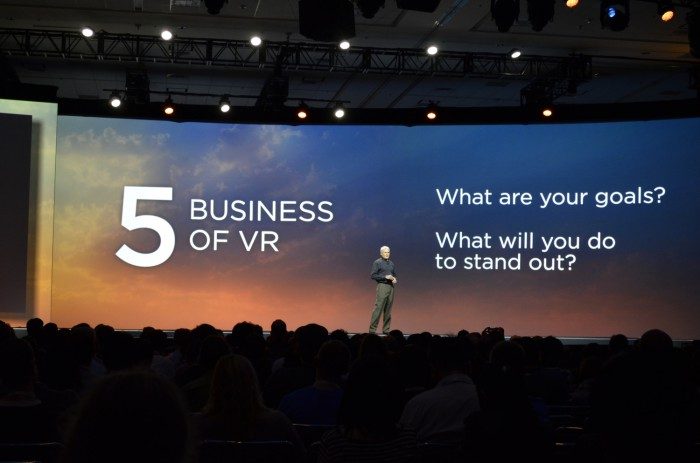At Samsung’s 2014 developer conference last week, Warren Mayoss, Head of Technology Product Development at DreamWorks Animation, took to the stage during the second day keynote to talk VR. Mayoss shared some of the initial work that DreamWorks has done with virtual reality, including five insights for new VR developers.
Mayoss, who worked previously with EA for many years, was crucial to the launch of DreamWorks’ virtual reality initiative which seeks to extend the company’s storytelling franchises into new immersive experiences. That initiative manifests in the ‘DreamLab’, led by Brad Herman, where the company is experimenting with virtual reality.
Mayoss said on stage at SDC 2014 that Dragon Flight 4D, a Rift-based promotional experience for How to Train Your Dragon 2 (2014), has been seen by more than 8,000 people. The company is now actively working on Samsung’s Gear VR as well, and some of that content was on display at the conference.
See Also: 13 Samsung Gear VR Titles Shown at SDC 2014
Mayoss, addressing a crowd of Samsung developers, had five insights to share with those looking to jump into VR development.
1. Develop for the Medium
“Don’t just assume that a flat screen will work. You really need to review your app, test your app, and play your app inside of a virtual reality headset,” Mayoss said.
He went on to urge developers to pay attention to scale. Without it, immersion can be broken, he told the crowd. “But if you get it right, it can be really magical.”
Mayoss shared an anecdote from when he showed his children the virtual reality work the company had been doing.
So I brought a prototype home to show my kids and this was the [Dragon Flight 4D] experience. The first part of it was a village scene with Astrid, who’s the main female character [in How to Train Your Dragon 2], and it was just a village environment… They got in and they were ‘oohing’ and ‘ahhing’ and looking around and it took a minute or two and then they explored the environment and what they noticed was that there was this giant pair of legs off to the right and they focused on it then they looked up and went ‘ooh’. And what it was, was this dragon that was tyrannosaurus-sized. After the initial shock, they both reached up and tried to touch it and pet it, and I thought… that’s really what we’re trying to do, to get people into it and let them feel that they’re part of that world. So, I knew then that the DreamLab was onto something at that point.
2. Real World Phobias May Translate to VR
Because VR is so immersive, developers have a responsibility to not only make experiences comfortable, but also not traumatic (unless of course that’s what the user wants). Mayoss stressed that real world phobias should be considered when developing for virtual reality.
“You don’t want to present people with too much of a shock when they’re getting into this for the first time,” he said. “We’ve experimented with being able to tone down the level of action and movement to try to give the experience that someone was comfortable with.”
3. VR is a New Medium
“It’s a new medium. It’s amazing. There’s this wow-factor when you first get into it,” said Mayoss. “What we found when people first tried it is that they’re blown away and what they want to do is just look around and explore the environment.” He impressed upon developers they should give users a chance to feel out the virtual world before cutting to the chase.
“What you don’t want to do is present them with a lot of menus and instructions to get them into the game. Get them get into the experience and let them get comfortable and then start to tell them what to do… guide them with what you want them to do,” rather than bombarding them with text and info.
4. Start Prototyping
VR is new, and like the early days of any medium, best-practices are still being defined. Methods for everything from functional UI design to avoiding sim sickess are still being uncovered. Time and time again we hear stories of researchers and developers deploying what seem like obvious solutions only to have their expectations crumpled up and tossed to the trash bin.
“Start prototyping and developing. The only way we’re going to understand what works in VR and what doesn’t is to actually just start developing,” Mayoss said. “For [Dragon Flight 4D], what we’ve done is keep people’s feet off the floor, so we provided an area where they can hook their legs up. This disconnects them from the ground, disconnects them from the real-world presence and they feel like they’re more into the application.”
Mayoss also talked about some interesting experimentation regarding sim sickness avoidance.
“We worry about motion sickness in these kinds of things so we’ve been experimenting with low-frequency vibrations and audio to try to make people more comfortable, it interrupts your processing…” Not much more was shared, but this is certainly something we hope to hear more about.
Mayoss went on to stress the importance of consistent performance in mobile VR and also had some technical ballpark targets for developers to aim for.
“For mobile VR, the high framerates and low latency requirements are very critical… A dropped frame, or low framerate can really break the sense of presence and immersion. So don’t try to compete on graphics like you’re used to seeing on other platforms,” he told the audience. “We try to stay to 50,000 static triangles for a particular frame and try to stay under 100 or so draw calls. Try to avoid lots of transparency and blending effects. Minimize your dynamic memory allocation and texture creation; everything is to keep that smooth framerate and I can’t emphasize that enough.”
See Also: Epic Games Share Insights: Optimizing ‘Showdown’ for 90 FPS on Oculus Rift Crescent Bay Prototype
5. Business of VR
Anyone involved in the world of virtual reality development this early has a massive opportunity to carve out a chunk of the market. Mayoss encourages developers to think about what will set them apart.
“We’re in the beginning, it’s in its infancy. Gear VR’s launch will help us in the mass market consumer proposition and so we think that app monetization will be similar to mobile,” he said. “You need to ask yourself what you want to do, what your goals are, and what you would do to stand out…”
DreamWorks is expected to have some content ready for Gear VR’s launch coming next month. The company is also further experimenting with bringing their content to VR at a level of visual fidelity that matches their films, something we hope to hear more about soon.

